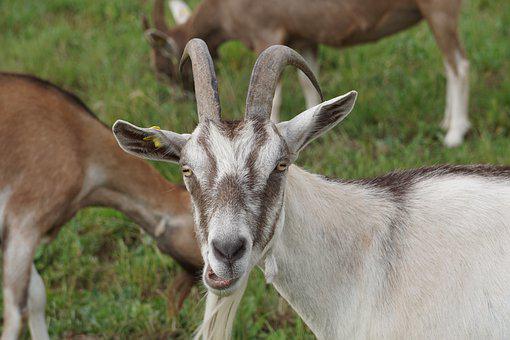
You have “goat” to hand it to the New York authorities, they can certainly think outside the box when it comes to tourist attractions. We are all familiar with the splendor of the Empire State Building, the magnificence of Brooklyn Bridge, the allure of the Statue of Liberty, the lights of Broadway and the scale of Central Park. Well you can add to that, for a couple of months at least anyway, the charm of the Riverside Park goats! That’s right… goats!
For the third time in four years (covid accounted for the missing year) a small part of Manhattan has become the “bleating heart” of New York City, once more. A herd from Green Goats Farm, in Rhinebeck, New York State, are again being given a “working holiday”, protecting an area’s native vegetation from rapidly spreading invasive plant species, by being tasked to munch their way through the unwelcome guests.
Riverside Park Conservancy
There are numerous projects that are on-going, all connected with a woodland restoration initiate, pioneered by the Riverside Park Conservancy. Excellent work and progress has been undertaken from 116th street to 119th street, but it is between 120th and 122nd street where matters become too tricky, with access to the steep slopes proving too difficult for manual labor. It is here that some species have been able to dominate the landscape and effectively run wild.
It is hoped eventually, with the goats assistance, that opportunities will present themselves to re-plant a diversity of native species, safe from the threat of the current uninvited inhabitants. The goats are made very comfortable, looked after by Conservancy staff and around 70 volunteers, who help to herd the goats back to a tented shelter each night, with professional veterinarian and horticultural assistance on standby, in case of any mishaps.
Why use goats?
Alison Ettinger-Delong, Communications and Development Coordinator at the Conservancy, said: “One of the most dire areas of the park is a very steep slope down to the Hudson River and it is very hard for human hands to actually get in there and remove the invasive species, and this had been a problem that was getting worse, year on year. The introduction of the goats is an environmentally-friendly way of removing these detrimental plants.” The invaders in question are porcelain berry, English ivy, multi-flora rose, and poison ivy. She added: These goats eat pretty much anything and traversing this slope is no problem at all for them. It literally is like treating them to an all-you-can-eat buffet, day after day.”
In effect, the goats are cheap labor, a full-time weeding gang, with “professional” know-how, and they require nothing more than a good feed in recompense, and that is precisely what they get throughout their “working” day. They can eat almost constantly, and consume 25% of their own body weight in vegetation, daily. Additionally, their fecal matter provides nutrients to the soil as they go about their business, so creating what could be described a “clean up and nurture” working practice. The added bonus is that whilst the goats tuck in, the Riverside Park Conservancy staff are free to work on other sides of the park restoration initiative.
Running of the goats
The initial release of the goats into the park has now become quite an event, even having its own promotional title: “the running of the goats” and drew a huge and noisy crowd, to greet the 20 strong weed-whacking herd, on their arrival earlier this month. The goats were released down a path and into a fenced-in field at the 120th street junction with the park, to loud cheers from children and adults alike.
Introducing the goats
Of the 20 goats that arrived on day one, only four of them: Skittles, Cheech, Elenor, and Big G, will actually properly get their hooves under the table, and stay for the full duration of the “assignment”.
Crowd reaction
There is such a positive vibe surrounding the reintroduction of the goats, which is reflected by the crowds who turned up on the first day and will undoubtedly continue to show up until the animals complete their task. As you might expect, the commercial teams have been at hard work and the inevitable merchandise is now freely available down at the park every day; but the good thing is that all proceeds go directly to the Riverside Park Conservancy.
John Herrold, the interim CEO of the Riverside Park Conservancy gave an introductory speech at the goats arrival: “I have the unique honor of ushering in the bevy of bovines this morning”, before commissioner Bill Castro joked: “Pamplona has the Running of the Bulls, we have the Running of the Goats!” Among the eager gathering was Upper West Side resident Katie Sabella who said: “I come here every year for this; I just love it!”
What is the project strategy?
Whilst the main aim for this years clearance is between 120th and 122nd streets, the enclosure that the goats are fenced in actually stretches from 119th to 125th streets, so plenty to go at. The goats will consume all the weeds right down to the roots, with the aim to stunt the invasive plants growth and hopefully eliminate its capability to regrow altogether. The project itself is known as the “Goatham” program.
What are the invasive species?
Each one of the invasive plants are different in their own right, yet similar in that they
grow out of control very rapidly, and are an ecological threat. The porcelain berry vine features lush, dense foliage, whereas the multi-flora rose is a climbing shrub, that can reach 15 feet in height.
The English ivy spreads out and basically envelops everything in its path, and impedes the photosynthesis process. Poison ivy however, is the one that really causes damage as its vines are capable of growing to quite alarming heights and it is remarkably adaptable, reacting to shade, or sunlight. Luckily though, the goats love them!
How long are they stopping?
The goats will remain in the park until the end of August, or the early part of September, depending on how quickly they can munch their way through their “meals” (they can typically get through 100 pounds a day, each!). Indeed, back in 2019, four of the herd used that year were effectively “sacked” for overindulging to such an extent, that there wasn’t enough weeds to share around the others in the herd.
Genuinely, not only do the goats help the park out with their “on-going work”, but they also increase visitor numbers, which in turn draws more attention to the great conservancy projects being carried out, increasing much needed awareness.



0 Comments